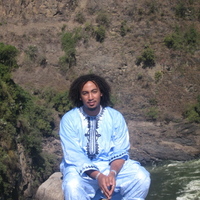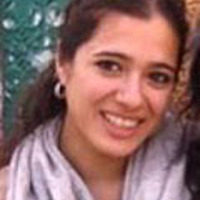
Monica Eileen Patterson
Monica Eileen Patterson is Assistant Director of Curatorial Studies in the Institute for the Comparative Study of Literature, Art, and Culture, and Associate Professor in the Institute of Interdisciplinary Studies at Carleton University in Ottawa, Canada. She received her Ph.D. in Anthropology and History from the University of Michigan. She is coeditor and contributing author of two books: "Curating Difficult Knowledge: Violent Pasts in Public Places" (Palgrave, 2011) and "Anthrohistory: Unsettling Knowledge, Questioning Discipline" (University of Michigan Press, 2011). As a scholar, curator, and activist, she is particularly interested in the intersections of memory, childhood, and violence in postcolonial Africa, and the ways in which they are represented and engaged in contemporary public spheres.
Her current book project examines the contested and conflicting constructions of childhood in late apartheid South Africa, from 1976 until the early 1990s when negotiations for the transition to democracy began.
Monica has conducted extensive fieldwork and archival research in South Africa and Zimbabwe, and has worked on a number of public history projects.
She holds a certificate in Museum Studies from the University of Michigan and has curated several exhibits based on her research.
Supervisors: David William Cohen
Phone: (613) 520-2600 ext. 3104
Address: Institute of Interdisciplinary Studies
Carleton University
2201 Dunton Tower
1125 Colonel By Drive
Ottawa, Ontario
Canada K1S 5B6
Her current book project examines the contested and conflicting constructions of childhood in late apartheid South Africa, from 1976 until the early 1990s when negotiations for the transition to democracy began.
Monica has conducted extensive fieldwork and archival research in South Africa and Zimbabwe, and has worked on a number of public history projects.
She holds a certificate in Museum Studies from the University of Michigan and has curated several exhibits based on her research.
Supervisors: David William Cohen
Phone: (613) 520-2600 ext. 3104
Address: Institute of Interdisciplinary Studies
Carleton University
2201 Dunton Tower
1125 Colonel By Drive
Ottawa, Ontario
Canada K1S 5B6
less
Related Authors
Noel B. Salazar
KU Leuven
Josiah Heyman
University of Texas at El Paso (UTEP)
Bjorn Enge Bertelsen
University of Bergen
Jo Tondeur
Vrije Universiteit Brussel
Alejandra B Osorio
Wellesley College
Oludamini Ogunnaike
University of Virginia
Anandini Dar
BML Munjal University
Beatrice Jauregui
University of Toronto
Cristiana Facchini
Università di Bologna
Mathias Urban
Dublin City University
InterestsView All (63)










Uploads
Books by Monica Eileen Patterson
Authors:
ERICA LEHRER is Assistant Professor in History and Anthropology-Sociology at Concordia University in Montreal, where she also holds the Canada Research chair in Post-Conflict Studies. She is author of Revisiting Jewish Poland: Heritage, Memory, Reconciliation (2012), and has undertaken experimental curatorial work on Jewish heritage and memory in contemporary Poland.
CYNTHIA E. MILTON is Canada Research Chair in Latin American History and Associate Professor in the Département d'histoire at the Université de Montréal, Canada. She is author of The Many Meanings of Poverty: Colonialism, Social Compacts, and Assistance in Eighteenth-Century Ecuador (2007), editor of The Arts of Truth-telling in Post-Shining Path Peru, and co-editor of The Art of Truth-Telling about Authoritarian Rule (2005).
MONICA EILEEN PATTERSON is a Postdoctoral Fellow at the Centre for Ethnographic Research and Exhibition in the Aftermath of Violence at Concordia University, Montreal, Canada. She is the author of numerous publications, and co-editor of Anthrohistory: Unsettling Knowledge, Questioning Discipline (2011).
Table of Contents:
List of Illustrations
List of Maps
Acknowledgements
Notes on Contributors
Introduction: Witnesses to Witnessing; E.Lehrer & C.E.Milton
PART I: BEARING WITNESS BETWEEN MUSEUMS AND COMMUNITIES
'We were so far away': Exhibiting Inuit Oral Histories of Residential Schools; H.Igloliorte
The Past is a Dangerous Place: the Museum as a Safe Haven; V.Szekeres
Teaching Tolerance through Objects of Hatred: The Jim Crow Museum of Racist Memorabilia as 'Counter-Museum'; M.E.Patterson
Politics of the Past: Remembering the Rwandan Genocide at the Kigali Memorial Center; A.Sodaro
PART II: VISUALIZING THE PAST
Living Historically through Photographs in Post-Apartheid South Africa: Reflections on Kliptown Museum, Soweto; D.Newbury
Showing and Telling: Photography Exhibitions in Israeli Discourses of Dissent; T.Katriel
Visualizing Apartheid: Re-framing Truth and Reconciliation through Contemporary South African Art; E.Mosely
PART III: MATERIALITY AND MEMORIAL CHALLENGES
Points of No Return: Cultural Heritage and Counter-Memory in Post-Yugoslavia; A.Herscher
Defacing Memory: (Un)tying Peru's Memory Knots; C.E.Milton
(Mis)representations of the Jewish Past in Poland's Memoryscapes: Nationalism, Religion and Political Economies of Commemoration; S.Kapralski
Afterward: The Turn to Pedagogy: a Needed Conversation on the Practice of Curating Difficult Knowledge; R.I.Simon
Index
Copyright © 2011 Macmillan Publishers Limited
Review:
'How to put difficult knowledge on public display is one of the biggest challenges for curators. It is also of major importance in contemporary civic life: what should be said and shown in museums, and how? This raises fascinating and complex intellectual and political questions. This book exposes and tackles these brilliantly through excellent discussion of a wide range of provocative cases. It should be read by anybody concerned with the dilemmas of curating difficult knowledge.' - Sharon Macdonald, Professor of Social Anthropology, University of Manchester, UK
This approach permits Anthrohistory to present a broader perspective that unsettles the constraints of existing academic practice. The volume does not offer a blueprint for fulfilling this goal, but rather a variety of positions taken by anthrohistorians who work in diverse contexts. Adopting an innovative and accessible style, Anthrohistory opens a provocative window into broader questions of interdisciplinarity, representation, epistemology, methodology, and social commitment.
Chandra D. Bhimull is Assistant Professor in the Department of Anthropology and the African American Studies Program at Colby College.
David William Cohen is Professor Emeritus of Anthropology and Professor Emeritus of History, College of Literature, Science, and the Arts, University of Michigan.
Fernando Coronil is Presidential Professor at the Graduate Center at the City University of New York and Professor Emeritus of Anthropology and Professor Emeritus of History, College of Literature, Science, and the Arts, University of Michigan.
Edward Murphy is Assistant Professor of History and Global Urban Studies at Michigan State University.
Monica Eileen Patterson is Postdoctoral Fellow at the Center for Ethnographic Research and Exhibition in the Aftermath of Violence at Concordia University in Montreal.
Julie Skurski is Distinguished Lecturer in Anthropology and History at the Graduate Center at the City University of New York.
~~~~~~~~~~~~~~~~~~~~~~~~~~~~~~~~~~~~~~~~~~~
Table of Contents
Illustrations
Openings
A Prefatory Piece, Chandra D. Bhimull, Edward Murphy, and Monica Eileen Patterson
The Pursuits of Anthrohistory: Formation against Formation, David William Cohen
I. Encountering Boundaries
Notes on the Difficulty of Studying ‘el Pueblo’, Paul K. Eiss
Step into Anthrohistory, David Pedersen
Genealogies of Mediation: ‘Culture Broker’ and Imperial Governmentality, E. Natalie Rothman
Childhood, Memory and Gap: Reflections from an Anthrohistorian on George Perec’s 'W or the Memory of Childhood', Monica Eileen Patterson
Working in the In-Between: Archives, Ethnography, and Research in Gaza, Ilana Feldman
The Past and Present of the Future Perfect in Anthropology and History, Deirdre de la Cruz
II. Unsettling Knowledge
Past Warfare: Ethics, Knowledge, and the Yanamomi Controversy, Julie Skurski
Disaster Preparedness, Shannon Lee Dawdy
Reclaiming Tradition, Zareena A. Grewal
Impressions: An Interval
The Miracle of History: Temporality and Un-certainty in Southern Arabia, Mandana E. Limbert
The Politics of Burial in Post-Apartheid South Africa, Kerry Ward
Losing the Phenomenon: Time and Indeterminacy in the Practice of Anthrohistory, Oana Mateescu
III. Questioning Discipline
Anthrohistory and Phantom Limb Syndrome: Transdisciplinarity in a Disciplinary World, Thomas C. Wolfe
On the Subject of Governance, Anupama Rao and Steven Pierce
Between Disciplines, After Modernity, S. C. Humphreys
The Politics of Naming: Ethical Dilemmas and Disciplinary Divides in Anthropology and History, Dorothy L. Hodgson
On the Importance of Having a Method, or What Does Archival Work on Soviet Atheism have to do with Ethnography of Post-Soviet Religion?, Sonja Luehrmann
Wanderings beyond Codification and Desire, Setrag Manoukian
Openings
Pieces for Anthrohistory: A Puzzle to be Assembled Together, Fernando Coronil
Contributors
Bibliography
Index
Special Issues of Journals Guest Edited by Monica Eileen Patterson
Papers by Monica Eileen Patterson
Key words: children, museum, curating, exhibitions, Poland
This article is open access and available on the Museum & Society website:
https://journals.le.ac.uk/ojs1/index.php/mas/article/view/3393
translated into Polish by Zuzanna Łopacińska-Piędel
15 lipca 2010 roku, około dwustuosobowa grupa obejmująca dzieci, pracowników służby zdrowia, działaczy społecznościowych, badaczy, przedstawicieli władz oraz osoby postronne zebrała się, by świętować otwarcie KwaZulu-Natal Children’s Hospital Restoration Project (kzn chrp)[Projekt Odbudowy Szpitala Dziecięcego w KwaZulu-Natal] w eThekwini (Durban), w Republice Południowej Afryki1. Zgromadzenie to odbyło się w kompleksie szpitalnym, gdzie wciąż jeszcze stał zniszczony budynek główny, owinięty teraz zszytym ciągiem białych kartek imitujących ogromny bandaż, spięty ogromną agrafką (patrz rys. 1). Wzdłuż płotów ochronnych otaczających teren umieszczono powiększone rysunki dziecięce wraz z tekstami opowiadającymi o początkach szpitala. Niestety, po tym dniu pełnym nadziei nadeszły miesiące frustracji, prace utknęły w martwym punkcie, szacowany koszt projektu znacząco wzrósł, a niewydane fundusze lokalne alokowane na odbudowę zwrócono Ministerstwu Finansów. Jednakże inicjatywa znów zaczyna się rozwijać, otwierając w ten sposób kolejny etap stulecia zmagań o ustanowienie i ochronę oddzielnego szpitala dziecięcego w regionie.
Niniejszy rozdział sytuuje się między kolejnymi wydarzeniami związanymi z pracami nad kzn chrp oraz moją wizją drogi rozwoju, którą pójść mogą ten i inne szpitale dziecięce2. Dzięki inspiracji ze strony wizjonerów, którzy prowadzą projekt, a także jego przyszłych pacjentów, wreszcie lokalnych południowoafrykańskich inicjatyw nadających się do wykorzystania w wielu różnych kontekstach, moje kuratorskie marzenie prezentuje unikalny potencjał muzeum szpitala opartego na sztuce oraz historii, stworzone przez dzieci oraz dla dzieci.
To address children's health in South Africa today is to intervene in history. In this chapter, I present my "curatorial dream" for the development of an exhibit in the KwaZulu-Natal Children's Hospital, which is currently being renovated. Inspired by the renovation project's visionary leaders, its future patients, and local South African initiatives that could be applied in a wide range of contexts, my curatorial dream presents the unique potential of an arts- and history-based hospital museum that is by and for children. A meaningful curatorial intervention would involve simultaneously re-envisioning what a children's hospital -- and a museum -- can be.
Based upon my experiences conducting ethnographic and historical research in South Africa, this chapter delves into the fraught terrain and “ethical murk” of using testimony for the production of scholarly and public knowledge. The South African context highlights the ways that interview processes must be seen – as they are often experienced by interviewees – as taking place within a broader domain of related and overlapping practices. I use the term “testimony” to denote the retelling of personal experience that occurs not only in the collection of oral histories, but at other sites of cultural and historical production. In South Africa, these include the Truth and Reconciliation Commission (TRC), museum work, documentary projects, media coverage, and the publication of scholarly and literary works, and often feature stories from a relatively small set of individuals, particularly (but not exclusively) in post-conflict settings. With its extensive publicity and the vast array of social and cultural industries that it has generated and sustained, the TRC raised the stakes of telling stories of trauma in ways that impinge upon both the storytellers and the researchers, journalists, and public culture workers who produce knowledge based on engagements with others’ experiences of the apartheid past. As the subjects of such scholarly work increasingly articulate their concerns, anxieties, and frustrations with the manner in which they have been represented and the political economy of the representations themselves, they force to the surface many dilemmas that have in fact always been present in the practice of oral historical research. While interviews and public testimony form the foundation of much of the knowledge production within the fields of history, anthropology, and even more practically-oriented arenas like transitional justice, my experiences in South Africa reveal that the fundamentally extractive process of collecting and analyzing testimony is rife with tensions and ethical ambiguities that cannot be resolved.
gathers fragments, gaps, and uncertainties in an attempt to write about a childhood he can’t remember. I happened quite unexpectedly upon this remarkable work, yet it so thoroughly captures, questions, and represents my own encounters with South African adults remembering
childhoods fringed by or grounded in trauma. In many ways Perec’s book is an organized, schematic attempt to access his early life using the tools and approaches of anthropologists and historians. But ultimately, it is only within the gaps between verifiable truths and misrememberings that Perec finds meaning in and access to past experiences.
need attention, support, acceptance, and care—as well as condemnation
and rejection of the acts that caused their suffering. Violence not
only shatters, it also embeds itself in the landscapes of the human heart
in ways that can never be completely understood. Opening up spaces
for empathy, respect, and inclusion without shocking, numbing, inciting,
or repelling presents great challenges.
Stepping into this fray, curatorial practice offers a paradox: on the one
hand, a productive space for engagement, understanding, and interaction;
on the other, the inescapable partiality of all attempts to redeem
and “reconcile,” often in contexts that knew no prior conciliation. In
such settings, as the authors in this section discuss, the implied call for
a “return” to an earlier, healthier state of coexistence risks not only distorting history, but potentially obscures the real work required to bring
opposed sides together. Curating difficult knowledge takes place within
fraught fields of temporal overlay and embedding: we look back at the
past for the sake of moving forward to a safe, secure future, often from
unsettled, unstable presents. The work of engaging with violence by
bringing it to light, putting it on display, and addressing its impact can
blur divisions between us and them, then and now, how things have
been and how they could, or should be. As many scholars have argued,
and as the chapters in this section illustrate, memory debates are always
as much about the present and future as they are about the past.
Patterson, Monica Eileen. “Introduction to Part I: Bearing Witness Between Museums and Communities.” In Curating Difficult Knowledge: Violent Pasts in Public Places, edited by Erica Lehrer, Cynthia Milton, and Monica Eileen Patterson, 21-22. New York: Palgrave Macmillan, 2011.
may resist feeling implicated or held accountable for others’ suffering, or
be simply indifferent to it. Even among sympathetic constituencies, there
is the danger of oversaturation and fatigue; a sense of numbing or even
paralysis can result from “overexposure.” Of course the thresholds for
each of these domains vary considerably among individuals and groups,
and these three responses are by no means exhaustive or mutually exclusive. But as the authors in this section discuss, visual materials and images can provide unique ways to breach or circumvent these barriers.
Patterson, Monica Eileen. “Introduction to Part II: Visualizing the Past.” In Curating Difficult Knowledge: Violent Pasts in Public Places, edited by Erica Lehrer, Cynthia Milton, and Monica Eileen Patterson, 89-90. New York: Palgrave Macmillan, 2011.
pushes us to take seriously the physical world, its attributes, possibilities,
and limitations: What are the agencies of the inanimate? Objects
and buildings also have lives, and exert influence and control over the
people who engage around and with them. Things and traces, architecture
and places, landscapes and spaces constrain and promote particular
memories. As societal palimpsests, they bear not only the marks of the
dominant players and their intended interpretations of the past, but
also subtler signs of the dispossessed, the destroyed, and the disappeared. Reading these physical memoryscapes, and engaging with the material world as a witness to and source of evidence of past conflict
requires certain literacies and perspectives.
Patterson, Monica Eileen. “Introduction to Part III: Materiality and Memorial Changes.” In Curating Difficult Knowledge: Violent Pasts in Public Places, edited by Erica Lehrer, Cynthia Milton, and Monica Eileen Patterson, 145-146. New York: Palgrave Macmillan, 2011.
Semantically, socially, intellectually, "childhood" is in its essence constructed in its meanings and usages. The political, cultural, and social work of childhood lies in these conventions. Suffering and violence vex and complicate the constructions of childhood in South Africa, where violence and childhood were structurally and practically linked through the apartheid system. Following the Soweto Uprising of 1976, images of children as victims of state-sponsored violence saturated South Africa and the world.
Within the context of the late apartheid period, the complex relationship between childhood and violence fuels new opportunities for additional reflection and debate by reopening questions about agency, responsibility, culpability, and consciousness for reconsideration and revision. It is impossible to settle on one definition of childhood in South Africa, where the child-youth continuum is one that has been especially open to manipulation by various kinds of actors, including children and youth themselves.
In exploring these issues I examine the Soweto Uprising of 1976, the Bantu Education System, the languages of Afrikaans and the pidgin known as Fanagalo, the United Nations International Year of the Child in 1979 and its counter version, South Africa‘s National "Year of Health," the historical shifts in the iconography and representative range of images of children in South African political posters from the 1980s, and South Africa‘s Truth and Reconciliation Commission Special Hearings on Children and Youth and The Winnie Madikizela-Mandela and the Mandela United Football Club.
Synopsis of "The Art of Truth-Telling about Authoritarian Rule," edited by Ksenija Bilibja, Jo Ellen Fair, Cynthia Milton, and Leigh Payne. (Madison: University of Wisconsin Press, 2005).
People who have lived through authoritarian rule have stories to tell. They want to tell their truths: truths that have been silenced, truths that have been censored, truths that are still uncomfortable. But how do individuals begin to speak about a political past that was too horrible for words, especially when the words only came in torrents of pabulum, snake oil, and venom? How are versions of events that have slipped outside of official narratives best voiced in a society moving out of authoritarianism? This generously illustrated volume examines the art of truth-telling and the creation of stories, accounts, images, songs, street theater, paintings, urban designs, and ideas that pay witness to authoritarian pasts. This comprehensive collection, with contributions by scholars, activists, and artists from around the world, explores this theme across a range of national experiences, each featuring its own unique set of historical, institutional, and cultural conditions. This book is bold, creative in form and content, and unlike any other treatment of authoritarian transitions, with the editors and contributors daringly staking a place for cross-disciplinary conversations on modern history, creative art, politics, and social meaning. By examining the truths-- both official and unofficial--about the past, we can learn how to avoid repeating atrocities in the future.
Authors:
ERICA LEHRER is Assistant Professor in History and Anthropology-Sociology at Concordia University in Montreal, where she also holds the Canada Research chair in Post-Conflict Studies. She is author of Revisiting Jewish Poland: Heritage, Memory, Reconciliation (2012), and has undertaken experimental curatorial work on Jewish heritage and memory in contemporary Poland.
CYNTHIA E. MILTON is Canada Research Chair in Latin American History and Associate Professor in the Département d'histoire at the Université de Montréal, Canada. She is author of The Many Meanings of Poverty: Colonialism, Social Compacts, and Assistance in Eighteenth-Century Ecuador (2007), editor of The Arts of Truth-telling in Post-Shining Path Peru, and co-editor of The Art of Truth-Telling about Authoritarian Rule (2005).
MONICA EILEEN PATTERSON is a Postdoctoral Fellow at the Centre for Ethnographic Research and Exhibition in the Aftermath of Violence at Concordia University, Montreal, Canada. She is the author of numerous publications, and co-editor of Anthrohistory: Unsettling Knowledge, Questioning Discipline (2011).
Table of Contents:
List of Illustrations
List of Maps
Acknowledgements
Notes on Contributors
Introduction: Witnesses to Witnessing; E.Lehrer & C.E.Milton
PART I: BEARING WITNESS BETWEEN MUSEUMS AND COMMUNITIES
'We were so far away': Exhibiting Inuit Oral Histories of Residential Schools; H.Igloliorte
The Past is a Dangerous Place: the Museum as a Safe Haven; V.Szekeres
Teaching Tolerance through Objects of Hatred: The Jim Crow Museum of Racist Memorabilia as 'Counter-Museum'; M.E.Patterson
Politics of the Past: Remembering the Rwandan Genocide at the Kigali Memorial Center; A.Sodaro
PART II: VISUALIZING THE PAST
Living Historically through Photographs in Post-Apartheid South Africa: Reflections on Kliptown Museum, Soweto; D.Newbury
Showing and Telling: Photography Exhibitions in Israeli Discourses of Dissent; T.Katriel
Visualizing Apartheid: Re-framing Truth and Reconciliation through Contemporary South African Art; E.Mosely
PART III: MATERIALITY AND MEMORIAL CHALLENGES
Points of No Return: Cultural Heritage and Counter-Memory in Post-Yugoslavia; A.Herscher
Defacing Memory: (Un)tying Peru's Memory Knots; C.E.Milton
(Mis)representations of the Jewish Past in Poland's Memoryscapes: Nationalism, Religion and Political Economies of Commemoration; S.Kapralski
Afterward: The Turn to Pedagogy: a Needed Conversation on the Practice of Curating Difficult Knowledge; R.I.Simon
Index
Copyright © 2011 Macmillan Publishers Limited
Review:
'How to put difficult knowledge on public display is one of the biggest challenges for curators. It is also of major importance in contemporary civic life: what should be said and shown in museums, and how? This raises fascinating and complex intellectual and political questions. This book exposes and tackles these brilliantly through excellent discussion of a wide range of provocative cases. It should be read by anybody concerned with the dilemmas of curating difficult knowledge.' - Sharon Macdonald, Professor of Social Anthropology, University of Manchester, UK
This approach permits Anthrohistory to present a broader perspective that unsettles the constraints of existing academic practice. The volume does not offer a blueprint for fulfilling this goal, but rather a variety of positions taken by anthrohistorians who work in diverse contexts. Adopting an innovative and accessible style, Anthrohistory opens a provocative window into broader questions of interdisciplinarity, representation, epistemology, methodology, and social commitment.
Chandra D. Bhimull is Assistant Professor in the Department of Anthropology and the African American Studies Program at Colby College.
David William Cohen is Professor Emeritus of Anthropology and Professor Emeritus of History, College of Literature, Science, and the Arts, University of Michigan.
Fernando Coronil is Presidential Professor at the Graduate Center at the City University of New York and Professor Emeritus of Anthropology and Professor Emeritus of History, College of Literature, Science, and the Arts, University of Michigan.
Edward Murphy is Assistant Professor of History and Global Urban Studies at Michigan State University.
Monica Eileen Patterson is Postdoctoral Fellow at the Center for Ethnographic Research and Exhibition in the Aftermath of Violence at Concordia University in Montreal.
Julie Skurski is Distinguished Lecturer in Anthropology and History at the Graduate Center at the City University of New York.
~~~~~~~~~~~~~~~~~~~~~~~~~~~~~~~~~~~~~~~~~~~
Table of Contents
Illustrations
Openings
A Prefatory Piece, Chandra D. Bhimull, Edward Murphy, and Monica Eileen Patterson
The Pursuits of Anthrohistory: Formation against Formation, David William Cohen
I. Encountering Boundaries
Notes on the Difficulty of Studying ‘el Pueblo’, Paul K. Eiss
Step into Anthrohistory, David Pedersen
Genealogies of Mediation: ‘Culture Broker’ and Imperial Governmentality, E. Natalie Rothman
Childhood, Memory and Gap: Reflections from an Anthrohistorian on George Perec’s 'W or the Memory of Childhood', Monica Eileen Patterson
Working in the In-Between: Archives, Ethnography, and Research in Gaza, Ilana Feldman
The Past and Present of the Future Perfect in Anthropology and History, Deirdre de la Cruz
II. Unsettling Knowledge
Past Warfare: Ethics, Knowledge, and the Yanamomi Controversy, Julie Skurski
Disaster Preparedness, Shannon Lee Dawdy
Reclaiming Tradition, Zareena A. Grewal
Impressions: An Interval
The Miracle of History: Temporality and Un-certainty in Southern Arabia, Mandana E. Limbert
The Politics of Burial in Post-Apartheid South Africa, Kerry Ward
Losing the Phenomenon: Time and Indeterminacy in the Practice of Anthrohistory, Oana Mateescu
III. Questioning Discipline
Anthrohistory and Phantom Limb Syndrome: Transdisciplinarity in a Disciplinary World, Thomas C. Wolfe
On the Subject of Governance, Anupama Rao and Steven Pierce
Between Disciplines, After Modernity, S. C. Humphreys
The Politics of Naming: Ethical Dilemmas and Disciplinary Divides in Anthropology and History, Dorothy L. Hodgson
On the Importance of Having a Method, or What Does Archival Work on Soviet Atheism have to do with Ethnography of Post-Soviet Religion?, Sonja Luehrmann
Wanderings beyond Codification and Desire, Setrag Manoukian
Openings
Pieces for Anthrohistory: A Puzzle to be Assembled Together, Fernando Coronil
Contributors
Bibliography
Index
Key words: children, museum, curating, exhibitions, Poland
This article is open access and available on the Museum & Society website:
https://journals.le.ac.uk/ojs1/index.php/mas/article/view/3393
translated into Polish by Zuzanna Łopacińska-Piędel
15 lipca 2010 roku, około dwustuosobowa grupa obejmująca dzieci, pracowników służby zdrowia, działaczy społecznościowych, badaczy, przedstawicieli władz oraz osoby postronne zebrała się, by świętować otwarcie KwaZulu-Natal Children’s Hospital Restoration Project (kzn chrp)[Projekt Odbudowy Szpitala Dziecięcego w KwaZulu-Natal] w eThekwini (Durban), w Republice Południowej Afryki1. Zgromadzenie to odbyło się w kompleksie szpitalnym, gdzie wciąż jeszcze stał zniszczony budynek główny, owinięty teraz zszytym ciągiem białych kartek imitujących ogromny bandaż, spięty ogromną agrafką (patrz rys. 1). Wzdłuż płotów ochronnych otaczających teren umieszczono powiększone rysunki dziecięce wraz z tekstami opowiadającymi o początkach szpitala. Niestety, po tym dniu pełnym nadziei nadeszły miesiące frustracji, prace utknęły w martwym punkcie, szacowany koszt projektu znacząco wzrósł, a niewydane fundusze lokalne alokowane na odbudowę zwrócono Ministerstwu Finansów. Jednakże inicjatywa znów zaczyna się rozwijać, otwierając w ten sposób kolejny etap stulecia zmagań o ustanowienie i ochronę oddzielnego szpitala dziecięcego w regionie.
Niniejszy rozdział sytuuje się między kolejnymi wydarzeniami związanymi z pracami nad kzn chrp oraz moją wizją drogi rozwoju, którą pójść mogą ten i inne szpitale dziecięce2. Dzięki inspiracji ze strony wizjonerów, którzy prowadzą projekt, a także jego przyszłych pacjentów, wreszcie lokalnych południowoafrykańskich inicjatyw nadających się do wykorzystania w wielu różnych kontekstach, moje kuratorskie marzenie prezentuje unikalny potencjał muzeum szpitala opartego na sztuce oraz historii, stworzone przez dzieci oraz dla dzieci.
To address children's health in South Africa today is to intervene in history. In this chapter, I present my "curatorial dream" for the development of an exhibit in the KwaZulu-Natal Children's Hospital, which is currently being renovated. Inspired by the renovation project's visionary leaders, its future patients, and local South African initiatives that could be applied in a wide range of contexts, my curatorial dream presents the unique potential of an arts- and history-based hospital museum that is by and for children. A meaningful curatorial intervention would involve simultaneously re-envisioning what a children's hospital -- and a museum -- can be.
Based upon my experiences conducting ethnographic and historical research in South Africa, this chapter delves into the fraught terrain and “ethical murk” of using testimony for the production of scholarly and public knowledge. The South African context highlights the ways that interview processes must be seen – as they are often experienced by interviewees – as taking place within a broader domain of related and overlapping practices. I use the term “testimony” to denote the retelling of personal experience that occurs not only in the collection of oral histories, but at other sites of cultural and historical production. In South Africa, these include the Truth and Reconciliation Commission (TRC), museum work, documentary projects, media coverage, and the publication of scholarly and literary works, and often feature stories from a relatively small set of individuals, particularly (but not exclusively) in post-conflict settings. With its extensive publicity and the vast array of social and cultural industries that it has generated and sustained, the TRC raised the stakes of telling stories of trauma in ways that impinge upon both the storytellers and the researchers, journalists, and public culture workers who produce knowledge based on engagements with others’ experiences of the apartheid past. As the subjects of such scholarly work increasingly articulate their concerns, anxieties, and frustrations with the manner in which they have been represented and the political economy of the representations themselves, they force to the surface many dilemmas that have in fact always been present in the practice of oral historical research. While interviews and public testimony form the foundation of much of the knowledge production within the fields of history, anthropology, and even more practically-oriented arenas like transitional justice, my experiences in South Africa reveal that the fundamentally extractive process of collecting and analyzing testimony is rife with tensions and ethical ambiguities that cannot be resolved.
gathers fragments, gaps, and uncertainties in an attempt to write about a childhood he can’t remember. I happened quite unexpectedly upon this remarkable work, yet it so thoroughly captures, questions, and represents my own encounters with South African adults remembering
childhoods fringed by or grounded in trauma. In many ways Perec’s book is an organized, schematic attempt to access his early life using the tools and approaches of anthropologists and historians. But ultimately, it is only within the gaps between verifiable truths and misrememberings that Perec finds meaning in and access to past experiences.
need attention, support, acceptance, and care—as well as condemnation
and rejection of the acts that caused their suffering. Violence not
only shatters, it also embeds itself in the landscapes of the human heart
in ways that can never be completely understood. Opening up spaces
for empathy, respect, and inclusion without shocking, numbing, inciting,
or repelling presents great challenges.
Stepping into this fray, curatorial practice offers a paradox: on the one
hand, a productive space for engagement, understanding, and interaction;
on the other, the inescapable partiality of all attempts to redeem
and “reconcile,” often in contexts that knew no prior conciliation. In
such settings, as the authors in this section discuss, the implied call for
a “return” to an earlier, healthier state of coexistence risks not only distorting history, but potentially obscures the real work required to bring
opposed sides together. Curating difficult knowledge takes place within
fraught fields of temporal overlay and embedding: we look back at the
past for the sake of moving forward to a safe, secure future, often from
unsettled, unstable presents. The work of engaging with violence by
bringing it to light, putting it on display, and addressing its impact can
blur divisions between us and them, then and now, how things have
been and how they could, or should be. As many scholars have argued,
and as the chapters in this section illustrate, memory debates are always
as much about the present and future as they are about the past.
Patterson, Monica Eileen. “Introduction to Part I: Bearing Witness Between Museums and Communities.” In Curating Difficult Knowledge: Violent Pasts in Public Places, edited by Erica Lehrer, Cynthia Milton, and Monica Eileen Patterson, 21-22. New York: Palgrave Macmillan, 2011.
may resist feeling implicated or held accountable for others’ suffering, or
be simply indifferent to it. Even among sympathetic constituencies, there
is the danger of oversaturation and fatigue; a sense of numbing or even
paralysis can result from “overexposure.” Of course the thresholds for
each of these domains vary considerably among individuals and groups,
and these three responses are by no means exhaustive or mutually exclusive. But as the authors in this section discuss, visual materials and images can provide unique ways to breach or circumvent these barriers.
Patterson, Monica Eileen. “Introduction to Part II: Visualizing the Past.” In Curating Difficult Knowledge: Violent Pasts in Public Places, edited by Erica Lehrer, Cynthia Milton, and Monica Eileen Patterson, 89-90. New York: Palgrave Macmillan, 2011.
pushes us to take seriously the physical world, its attributes, possibilities,
and limitations: What are the agencies of the inanimate? Objects
and buildings also have lives, and exert influence and control over the
people who engage around and with them. Things and traces, architecture
and places, landscapes and spaces constrain and promote particular
memories. As societal palimpsests, they bear not only the marks of the
dominant players and their intended interpretations of the past, but
also subtler signs of the dispossessed, the destroyed, and the disappeared. Reading these physical memoryscapes, and engaging with the material world as a witness to and source of evidence of past conflict
requires certain literacies and perspectives.
Patterson, Monica Eileen. “Introduction to Part III: Materiality and Memorial Changes.” In Curating Difficult Knowledge: Violent Pasts in Public Places, edited by Erica Lehrer, Cynthia Milton, and Monica Eileen Patterson, 145-146. New York: Palgrave Macmillan, 2011.
Semantically, socially, intellectually, "childhood" is in its essence constructed in its meanings and usages. The political, cultural, and social work of childhood lies in these conventions. Suffering and violence vex and complicate the constructions of childhood in South Africa, where violence and childhood were structurally and practically linked through the apartheid system. Following the Soweto Uprising of 1976, images of children as victims of state-sponsored violence saturated South Africa and the world.
Within the context of the late apartheid period, the complex relationship between childhood and violence fuels new opportunities for additional reflection and debate by reopening questions about agency, responsibility, culpability, and consciousness for reconsideration and revision. It is impossible to settle on one definition of childhood in South Africa, where the child-youth continuum is one that has been especially open to manipulation by various kinds of actors, including children and youth themselves.
In exploring these issues I examine the Soweto Uprising of 1976, the Bantu Education System, the languages of Afrikaans and the pidgin known as Fanagalo, the United Nations International Year of the Child in 1979 and its counter version, South Africa‘s National "Year of Health," the historical shifts in the iconography and representative range of images of children in South African political posters from the 1980s, and South Africa‘s Truth and Reconciliation Commission Special Hearings on Children and Youth and The Winnie Madikizela-Mandela and the Mandela United Football Club.
Synopsis of "The Art of Truth-Telling about Authoritarian Rule," edited by Ksenija Bilibja, Jo Ellen Fair, Cynthia Milton, and Leigh Payne. (Madison: University of Wisconsin Press, 2005).
People who have lived through authoritarian rule have stories to tell. They want to tell their truths: truths that have been silenced, truths that have been censored, truths that are still uncomfortable. But how do individuals begin to speak about a political past that was too horrible for words, especially when the words only came in torrents of pabulum, snake oil, and venom? How are versions of events that have slipped outside of official narratives best voiced in a society moving out of authoritarianism? This generously illustrated volume examines the art of truth-telling and the creation of stories, accounts, images, songs, street theater, paintings, urban designs, and ideas that pay witness to authoritarian pasts. This comprehensive collection, with contributions by scholars, activists, and artists from around the world, explores this theme across a range of national experiences, each featuring its own unique set of historical, institutional, and cultural conditions. This book is bold, creative in form and content, and unlike any other treatment of authoritarian transitions, with the editors and contributors daringly staking a place for cross-disciplinary conversations on modern history, creative art, politics, and social meaning. By examining the truths-- both official and unofficial--about the past, we can learn how to avoid repeating atrocities in the future.
https://www.aam-us.org/2020/09/18/childrens-museology-and-the-covid-19-crisis/?fbclid=IwAR2BickSCZfkdhmV2lPT5holxaygxLivAaXrfbOEqX9O3RmENX93ixMS968
But if you are one of those millions bringing a souvenir home, think twice before filling your suitcase with mementos from the island.
As a professor of anthropology and history, I was surprised to find rows upon rows of racist memorabilia during a recent trip to Cuba. These souvenirs, including sculptures, figurines and wall hangings, draw from a range of familiar images and ideas used across the globe for centuries to normalize the subjugation of Africans and Black people in contexts ranging from colonial Africa to the Jim Crow era in the United States.
"Always use the word ‘Africa’ or ‘Darkness’ or ‘Safari’ in your title. Subtitles may include the words ‘Zanzibar’, ‘Masai’, ‘Zulu’, ‘Zambezi’, ‘Congo’, ‘Nile’, ‘Big’, ‘Sky’, ‘Shadow’, ‘Drum’, ‘Sun’ or ‘Bygone’. Also useful are words such as ‘Guerrillas’, ‘Timeless’, ‘Primordial’ and ‘Tribal’. Note that ‘People’ means Africans who are not black, while ‘The People’ means black Africans."
The Miniature Guide to The Foundation for Critical Thinking www.criticalthinking.org
707-878-9100
cct@criticalthinking.org
Visual Map of Paul-Elder Critical Thinking Model:
https://louisville.edu/ideastoaction/about/criticalthinking/framework
"Talking about Tribe"
by Chris Lowe, Africa Policy Information Center
with Tunde Brimah, Pearl-Alice Marsh, William Minter, Monde Muyangwa
Washington, DC
Originally published November 1997, Updated 2008
Publisher: Africa Policy Information Center
8 pages
Contents: What's Wrong With "Tribe?" • CASE IN POINT Zambia • If "Tribe" Is So Useless, Why Is it So Common? • CASE IN PONIT Hutu/Tutsi • But Why Not Use "Tribe?" Answers to Common Arguments • CASE IN POINT Zulu Identity in South Africa • CASE IN POINT The Yoruba People • For Further Reading
Museums at Sites of Conflicted History conference
https://www.youtube.com/watch?v=GLeNpTTm1-s
Deadline for submissions: March 30, 2022
Contact email: childrensmuseologyvolume@gmail.com
Editors:
Monica Eileen Patterson
Assistant Director, Curatorial Studies
Institute for the Comparative Study of Literature, Art, and Culture
Associate Professor, Childhood and Youth Studies
Institute of Interdisciplinary Studies
Carleton University
Ceciel Brouwer
Research Associate
Research Centre for Museums and Galleries
School of Museum Studies
University of Leicester
Focus and key questions:
> How can children’s active participation and contribution foster change in museum practice?
> What are the possibilities and challenges of bringing child-centred praxis into museology?
> What examples and future possibilities exist for museums to engage children as valued social agents, knowledge-bearers, and active contributors rather than mere receivers of museum content and programming provided for them by adults?
> How can museums better share authority with children and break from the adult-dominated status quo?
> What can children’s museology do? What is the value and potential impact of this work?
Please email an abstract of 500-800 words (including key references) and a short bio of each author to guest editors by February 1, 2020 at artintimesofcrisis@gmail.com
https://journals.sagepub.com/pb-assets/Children%E2%80%99s%20Art%20in%20times%20of%20Crisis.pdf?fbclid=IwAR3QYvm0G4VJLLX3Kqpc8-GNThqGke0E1924JUpVMo3AeMlHh5C4N0U4fhM
This special issue of Global Studies of Childhood focuses on children's art and its relation to social crises. Child Studies scholars, psychologists, educators, clinicians, and curators have long held that making art helps children process and socialize difficult experience. This special issue explores the affective, aesthetic, emotional, social, and political processes involved in the making and sharing of art, placing emphasis on the potential for art to offer insight into the circumstances, consequences, and urgencies of crisis. We aim to bring together articles that address children's use of art to process, symbolize, and communicate their experiences and histories of migration, war, surveillance, social crises, political turmoil, and survival. David Marshall has written extensively about the relationship between trauma, aesthetic expression, and politics in Palestine. For Ruth Nicole Brown, "the desire to play with movement, sound, images, and words against the assumable or knowable figure of the Black girl is very much a part of her creative process". i Glynis Clacherty and Diane Welvering's "The Suitcase Project" has used art therapy and storytelling to offer psychosocial support to refugee children in South Africa. In Lives Turned Upside Down: Homeless Children in Their Own Words and Photographs, Jim Hubbard archives images made by children ages nine to twelve, that reflect their experiences with homelessness and life in shelters. Taken together, this body of work demonstrates the power of arts-based approaches to working with children. Children's art has been mobilized by a range of actors as testimony to racism, war, apartheid, abuse, resilience, and optimism, and when taken seriously, raises inquiry into its meaning, narrative, and interpretation.
We aim to solicit an interdisciplinary collection of articles produced from a range of fields that share an investment in bridging child studies, art/aesthetics, politics, and pedagogy. Children's art harnesses considerable affective power and as a result is and has been historically mobilized and reproduced by non-profit and political organizations for fundraising purposes, PR maneuvers, and neo-liberal campaigns. Its affective capacities, though, can also galvanize its audiences towards new ethical feelings about and responses to injustice. In asking how making, curating, and witnessing children's art helps to register children's agency, we seek articles that open up new lines of inquiry for child studies. Because, as Robin Bernstein, Julian Gill-Peterson, Erica Meiners, Rebekah Sheldon, and Kathryn Bond Stockton have rightly shown, discourses of innocence can impact children's subject formation, making art can remind others of their complexity. The editors encourage the submission of work that engages childhood in relation to race, citizenship, disability, ethnicity, gender, sexuality, and class.